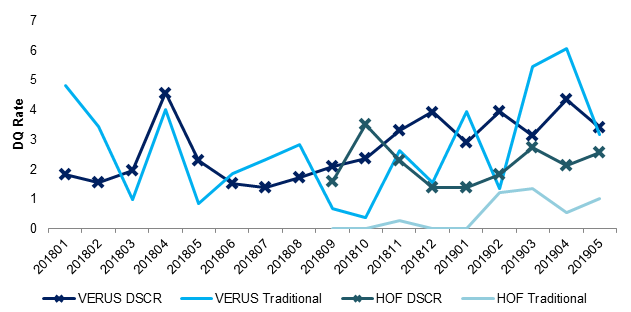Uncategorized
A new twist in investor loans in non-QM
admin | June 14, 2019
This document is intended for institutional investors and is not subject to all of the independence and disclosure standards applicable to debt research reports prepared for retail investors.
Loans backed by investment properties have started flowing into non-QM MBS deals with a new twist: underwriting closer to CMBS than RMBS. Investor loans underwritten more to debt service coverage ratios or DSCR rather than borrower income have become a large part of some non-QM securitizations. Prepayment speeds on DSCR loans appear to be more predictable and credit performance relatively benign, but the relatively novel form of underwriting is still untested.
Investor loans fall outside the bounds of QM
Loans backed by investment properties have become a significant contributor to overall private MBS issuance since the beginning of last year. And while these loans often surface in non-QM deals, they are not technically either QM or non-QM. The investor loans are backed by 1- to 4-family residences, but they fall outside the scope of the Qualified Mortgage rules because they are commercial and not consumer loans. Their exempt status gives originators latitude to underwrite using non-traditional means. Originators still use a borrower’s FICO and LTV, but instead of using the borrower’s income the originator uses actual or estimated rental incomes often in combination with the borrower’s assets.
Investor Debt Service Coverage Ratio (DSCR) loans have become more prevalent in certain non-QM trusts. Screening for these loans is not an exact science, however, given inconsistent data disclosure across issuers. A good clue to DSCR loans is the absence of borrower debt-to-income (DTI) ratio as the originator can only calculate it by verifying the borrower’s income. By definition these loans should also be non-full documentation loans given the lack of income verification. (Exhibit 1)
Exhibit 1: Estimated population of DSCF loans in non-QM trusts

Source: Amherst Insight Labs, Amherst Pierpont Securities
Identifying DSCR loans through missing DTI ratios squares with rating agency disclosures. Per S&P, for example, none of the mortgage loans in VERUS 2018-INV1 or VERSUS 2018-INV2 use the mortgagors’ incomes for underwriting, in line with 100% missing DTI. Further, S&P identifies 26% of the collateral in HOF 2018-1 as underwritten using DSCR/asset depletion underwriting, generally consistent with an estimate of 23% from missing DTI.
A history of more stable prepayments
Comparing prepayment trends across DSCR and traditional investor loans suggests that prepayment rates on DSCR loans tend to be relatively more stable. Focusing on two shelves with the largest populations of DSCR loans as a percentage of overall issuance, Invictus’ VERUS shelf and Neuberger Berman’s Homeward Opportunities (HOF) shelf, suggests that prepayment rates DSCR loans tend to be lower and less volatile. This simple analysis does not control for key prepayment characteristics like refi incentive and loan size. With that caveat, prepayment speeds on DSCR loans should nevertheless be more stable for the near term given the limited number of channels for refinancing these loans. (Exhibit 2)
Exhibit 2: Shelf level prepayments – DSCR and traditional investor loans

Source: Amherst Insight Labs, Amherst Pierpont Securities
No clear differences so far in credit
Comparing delinquency rates across DSCR and traditional investor loans across the two programs shows relatively benign credit performance across both types of loans and no clear difference in performance between the two. Delinquency rates on DSCR loans in the VERUS program appear to be somewhat consistent and modestly elevated versus the traditional investor loans. Delinquency rates on traditional investor loans are more volatile and have been modestly higher than those of DSCR loans in certain months where DQ rates on traditional investor loans have been up to 250 bp more than DSCR loans. The difference in performance is more pronounced in the HOF program, where delinquency rates on DSCR loans have been consistently higher than traditional investor loans by 150 bp or more. While credit performance has been relatively consistent and benign across both types of investor loans, home prices and rents have steadily appreciated through most of the lives of these shelves. Given that a CMBS-style underwriting is relatively unproven in residential mortgage origination, it is hard to predict how credit performance may diverge on these types of loans in a downturn in home prices and rents. (Exhibit 3)
Exhibit 3: Shelf level delinquency rates – DSCR and traditional investor loans

Source: Amherst Insight Labs, Amherst Pierpont Securities
No compensating attributes
Comparing DSCR loans to more traditionally underwritten investor loans in the same trusts suggests that there is little in the way of collateral characteristics to compensate for the lack of borrower income verification. Of the $1.6 billion in investor loans across the 17 trusts with meaningful concentrations of DSCR loans, more than 70% of those loans were underwritten with no borrower income verification. The DSCR loans had an average WAC nearly 100 bp higher than traditionally underwritten investor loans. The DSCR borrowers had an average FICO seven points lower and an average LTV two points less than traditional investor loans. Both sets of investor loans had a significant concentration of cash out refinancing;. 47% of the DSCR loans were also cash out refis. Despite the large population of cash out refis, the average LTV on the DSCR loans were 64. (Exhibit 4). That means the market has a clear view so far of differences in prepayments and credit across loans distinguished largely by the difference between DSCR and traditional income underwriting.
Exhibit 4: A comparison of DSCR and traditional investor loans in non-QM trusts

Source: Amherst Insight Labs, Amherst Pierpont Securities


